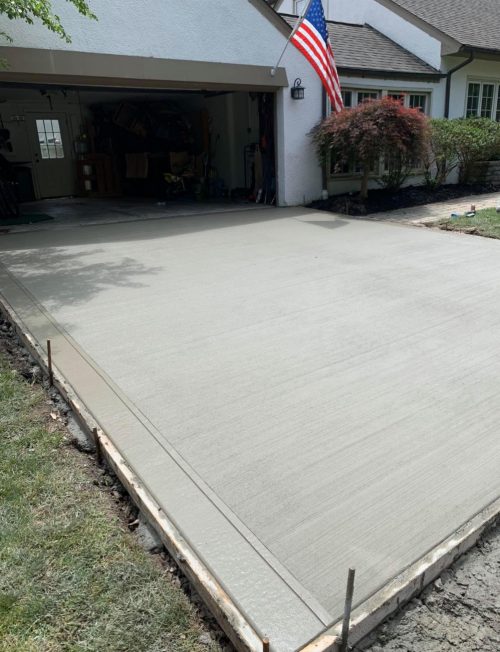The Eco-friendly Selection: Concrete Sidewalks for Your Community
Concrete walkways are an ubiquitous feature in many communities, yet their influence on the environment is often ignored. However, picking concrete for your community sidewalks can make a significant distinction in terms of sustainability and eco-friendliness. The advantages of choosing concrete surpass mere appearances and performance. By considering the environmental benefits and long-lasting results on the neighborhood, the selection of materials for pathways comes to be a vital choice. Let's discover why concrete pathways may be the environment-friendly selection your neighborhood needs.
Advantages of Concrete Sidewalks
When thinking about the installation of sidewalks in an area, the benefits of choosing concrete over other products are various and substantial. Concrete pathways provide sturdiness, standing up to hefty foot website traffic, weather condition fluctuations, and environmental elements much better than alternate products like asphalt or gravel. This long life converts to cost-effectiveness over time, as concrete pathways call for much less regular repair services and upkeep. In addition, concrete is a versatile material that can be quickly tailored to match the visual of any kind of community with different coatings, shades, and patterns.

Toughness and Longevity
Just how can concrete sidewalks outshine other materials in regards to sturdiness and long life? Concrete sidewalks are renowned for their phenomenal resilience and longevity compared to alternative materials like asphalt or pavers. The fundamental strength of concrete makes it very resistant to fracturing, changing, and basic damage created by foot website traffic, weather fluctuations, and various other ecological variables. Unlike asphalt, which can soften in high temperature levels and fracture in freezing problems, concrete maintains its architectural honesty, needing very little upkeep in time.
Concrete pathways likewise have a longer life-span than pavers, which are vulnerable to irregular settling, weed growth between joints, and private paver motion. The strong, continuous surface of concrete minimizes stumbling threats and ensures a smooth strolling path for pedestrians. Furthermore, concrete's longevity decreases the demand for regular fixings or substitutes, making it a description lasting and affordable option for area sidewalks. By purchasing concrete sidewalks, communities can appreciate a reliable and durable framework that enhances the overall visual allure and performance of the location.
Low Maintenance Requirements
Concrete sidewalks stick out for their marginal maintenance requirements as a result of their sturdy nature and long-lasting efficiency. Unlike alternate materials that may need frequent repair services or substitutes, concrete pathways offer a cost-effective remedy that demands little maintenance in time. One of the key advantages of concrete walkways is their resistance to weathering and erosion. This implies they can stand up to severe weather, heavy foot web traffic, and various other ecological factors without deteriorating rapidly.
Regular maintenance for concrete walkways generally entails basic jobs such as regular cleansing to remove particles and periodic securing to safeguard the surface. In comparison to materials like asphalt or pavers that may shift, crack, or break down more easily, concrete sidewalks keep their architectural integrity with very little intervention. Furthermore, any kind of fixings that may be needed are usually local and can be addressed quickly, lowering both the moment and cost associated with upkeep.

Environmental Advantages
With a focus on sustainability and eco-friendliness, concrete walkways offer notable ecological advantages that add to a greener community infrastructure. In addition, concrete walkways have a high solar reflectance index, suggesting they show a significant amount of sunshine instead of absorbing and keeping heat.
In addition, concrete is a permeable material that permits water to penetrate right into the ground, decreasing stormwater overflow and assisting in view publisher site groundwater recharge. This assists avoid disintegration, minimize flooding, and preserve the natural balance of water systems in your area. By selecting concrete walkways, neighborhoods can make a lasting choice that favorably affects the setting and improves the lifestyle for homeowners.
Enhancing Community Sustainability
By focusing on sustainable facilities remedies, neighborhoods can grow an unified equilibrium in between ecological awareness and community growth. Enhancing community sustainability includes a diverse approach that goes beyond simply the environmental advantages of concrete walkways. Applying environment-friendly rooms, advertising energy-efficient methods, and fostering a feeling of area engagement are crucial components of producing a lasting neighborhood.
One means to enhance area sustainability is through the combination of absorptive concrete walkways. These sidewalks enable rain to leak into the ground, lowering stormwater runoff and minimizing the stress on metropolitan drainage systems. Concrete Companies Near Me. By incorporating absorptive pathways, areas can boost water top quality, decrease flooding dangers, company website and improve total ecological strength
In addition, promoting alternate transport methods such as walking and biking can dramatically reduce carbon discharges and advertise a healthier way of living among homeowners. Producing risk-free pedestrian pathways, bike lanes, and designated greenways can motivate locals to rely less on vehicles, better adding to the neighborhood's sustainability goals.
Verdict
Finally, concrete walkways supply countless benefits for neighborhoods, consisting of durability, reduced upkeep needs, and ecological benefits. By choosing concrete pathways, neighborhoods can improve their sustainability and add to a much more green atmosphere. It is clear that concrete sidewalks are the ideal choice for areas looking to boost their infrastructure in a ecologically friendly and long-lasting manner.
When taking into consideration the installment of sidewalks in a community, the advantages of choosing concrete over other products are countless and significant. Additionally, concrete's longevity decreases the requirement for regular repair services or replacements, making it a cost-effective and sustainable choice for neighborhood sidewalks (Concrete Contractor).With a focus on sustainability and eco-friendliness, concrete sidewalks provide noteworthy ecological benefits that contribute to a greener neighborhood facilities. Enhancing community sustainability entails a complex method that goes past simply the environmental benefits of concrete sidewalks.In final thought, concrete sidewalks supply countless benefits for areas, consisting of sturdiness, low upkeep demands, and environmental advantages